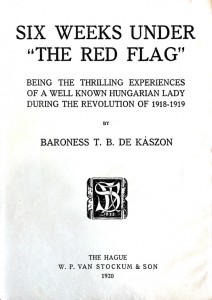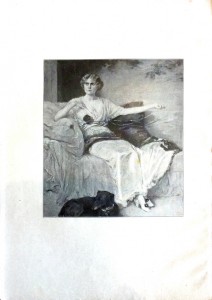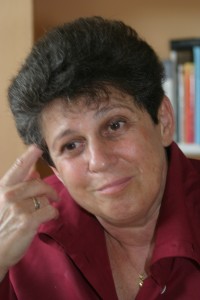Simone Derix Shrouds Thyssen Guilt – Rechnitz Revisited II
|
The Thyssens have always avoided revealing the details of their Nazi past, relying on a mixture of denial, obfuscation and bribery. But with the publication of our book ‘The Thyssen Art Macabre’ in 2007 and revelations concerning the appalling Rechnitz massacre, this philosophy was becoming increasingly difficult to uphold. Finally they decided to recruit ten academics, via the Fritz Thyssen Foundation, to rewrite their personal, social, political and industrial past (a series called ‘Family – Enterprises – Public. Thyssen in the 20th Century’) in an attempt to burnish their reputation. Sometimes this has been successful and sometimes not, as, despite their best laid plans, the books have often revealed more than the Thyssens might have liked, either directly or through the exposure of contradictions. As the Thyssen-sponsored treatises have been published, we have reviewed each one in turn, in some considerable detail, and intend to do the same with their latest offering, ‘The Thyssens. Family and Fortune’ by Simone Derix. First, though, we want to examine the book’s one unique feature as, a whole decade after our revelations, the Fritz Thyssen Foundation has finally helped issue the first official Thyssen publication that contains a description of the dynasty’s involvement in Rechnitz life and in the ‘Rechnitz massacre’ of 24/25 March 1945 in particular – because this is a subject which we feel particularly passionate about. Unfortunately, the Fritz Thyssen Foundation has chosen to allow Simone Derix to include the mere seven pages (of a 500-page book, derived from her habilitation thesis) in a manifesto that is as much a work of public relations on behalf of the Thyssens, as of Derix’s ambitious self-promotion within the ‘new’ field of ‘research into the wealthy’; the bottom line being that the Thyssens should be celebrated for their outstanding wealth, while they must be pitied for their victimisation at the hands of journalists, advisors, authorities, relatives, Bolshevists, National Socialists, etc., etc. This makes Derix the kind of apologist of whom Ralph Giordano said that they will not tire of ‘turning victims into perpetrators and perpetrators into victims’. The fact that the Association of German Historians has seen fit to award Derix’s work the Carl-Erdmann-Prize (named after a genuine victim of Nazi persecution) is furthermore troubling. * * * Germany was a late developer in both its industrialisation and nationhood and emerged onto the international stage with an explosive energy that was to become catastrophic. While the extraordinarily hard-working, middle-class brothers August and Josef Thyssen created their family’s vast, late 19th century industrial fortune, August’s sons Fritz Thyssen and Heinrich Thyssen-Bornemisza, influenced by their socially ambitious mother, turned their backs on bourgeois life and used their inherited wealth to ascend into a new-style, deeply reactionary landed gentry. Derix describes how, in the early 20th century, far away from the original Thyssen base in the Ruhr, Fritz leased Rittergut Gleina near Naumburg/Saale, bought and sold Rittergut Götschendorf in Uckermark and bought Rittergut Neu Schlagsdorf near Schwerin, as well as Schloss Puchhof in Bavaria. Of course we already knew that Heinrich acquired, amongst others, the Landswerth horse racing stables near Vienna, the Erlenhof stud farm near Bad Homburg, with racing stables in Hoppegarten near Berlin, and the Rechnitz estate in Burgenland/Austria (formerly in Hungary). Our research has shown that the brothers hunted at each other’s estates which discredits the spurious allegation repeated again and again by this academic series, including Derix, that Fritz and Heinrich Thyssen did not get on. A claim which is designed to obfuscate the synergies in the two men’s business dealings and particularly those benefitting the Nazi regime. Both men adopted the behaviour of feudal overlords, enjoying the supplies of cheap and forced labour afforded their enterprises by the suppression of labour movements as well as armed international conflicts, which they fuelled with their factories’ weapons and munitions. The Thyssen brothers self-servingly meddled in politics, overtly (Fritz) or behind the scenes, through discrete diplomatic and society channels (Heinrich) – though the latter is denied vehemently by Derix and her academic associates. Both Thyssen brothers helped bring about the eventual enthronement of the Nazis in 1933. Yet Simone Derix tries to reinvent them as the guiltlessly entrapped, illustrious captains of industry they never were in the first place. By 1933 Heinrich’s daughter Margit (who had been born and had grown up at Rechnitz castle), corrupted by her ambitious father and anti-semitic mother, as well as her pseudo-pious Sacré Coeur education, had managed to elevate the family by marrying into Hungarian aristocracy (Ivan Batthyany) – as had Fritz Thyssen’s daughter Anita (Gabor Zichy). On 8th April 1938, one week after the annexation of Austria by Nazi Germany, Heinrich Thyssen-Bornemisza gave his Rechnitz estate, which had once been in the Batthyany family for centuries from 1527 to 1871, to Margit, according to our research apparently so that he, ensconced in his Swiss hide-away on the shores of Lake Lugano, would not be seen to own any property in the German Reich. Simone Derix alleges this was instead done for tax reasons. All his Ruhr factories being owned by Dutch financial instruments, the Swiss authorities, who until the turning point of the war in 1943 were pro-German but whose ultimate stance was one of political neutrality, were satisfied that Heinrich would not become a political problem to them. Through his company Thyssensche Gas- und Wasserwerke (later Thyssengas), Heinrich Thyssen-Bornemisza discreetly continued to fund both Rechnitz castle and the Batthyany matrimony. During WWII, the Walsum coal mine belonging to Thyssengas in the Ruhr used forced labour to the tune of two thirds of its labour force; a record in German industry. In the Rechnitz area, some mining interests were being exploited by the Thyssengas company. * * * For centuries the huge Rechnitz castle, in whose courtyard, it was said, an entire husars regiment could perform its drill, had been the power centre of Rechnitz. How exactly did this situation develop after the Nazis took charge of the country? Where in Rechnitz did the party and its organisations install themselves? Simone Derix does not furnish any answers to these important questions, despite pretending to do so, by help of much verbose flourish. Instead, she writes in a vague, evasive manner: ‘The Batthyanys got along by mutual agreement (they found a consensual livelihood) at Rechnitz Castle during World War Two with representatives of the Nazi party and the Nazi regime’. In 1934, 170 Jews lived in Rechnitz. On 1st November 1938, a week before Reichs Crystal Night, Rechnitz was declared ‘free of Jews’, a situation that members of the Thyssen family would have welcomed (see here). But Simone Derix pointedly refuses to acknowledge the anti-semitism of key Thyssens and instead reserves this characteristic for marginal characters. In the spring of 1939, according to Derix, Hans-Joachim Oldenburg, whose father was a senior engineer at Thyssen and who himself had worked on agricultural estates owned by the Thyssen family, was sent to Rechnitz Castle to take charge of its estate management, which was soon relying on forced labourers from all over Nazi-occupied Europe. That summer, Franz Podezin arrived in Rechnitz as a civil servant of the Gestapo border post. He had been an SA-member since 1931 and later became SS-Hauptscharführer. He also became the leader of the Nazi party in Rechnitz. Simone Derix comments that „both posts of Podezin were in different locations“, but fails to pinpoint them. Stefan Klemp of the Simon Wiesenthal Centre has written that the Rechnitz Gestapo was headquartered in Rechnitz castle all along. Either his statement is correct or Derix is right when she alleges that Podezin only came to take up offices in the castle in the autum of 1944 when he became Nazi party head of subsection I of section VI (Rechnitz) of the South-East Earth Wall building works. By avoiding clarity on these points, Derix fudges the issue and contributes to the vindication of culprits – particularly of the Thyssens as owners, funders and residents of the castle. The activities on this reinforced defense system designed to hold up the Red Army were coordinated by the organisation Todt (run by Armaments Minister Albert Speer), by the Wehrmacht major-general Wilhelm Weiss and, in the section in question, by the Gauleiter of Styria, to which Burgenland then belonged, Sigfried Uiberreither. Locals as well as forced labourers from different nations were employed, whose treatment depended on their position within the racial hierarchies proclaimed by Nazi ideology. Bottom of the heap and therefore having to endure the worst conditions and abuses, were Slavs, Russians and nationals of the states of the Soviet Union. But none of them were as badly treated as the Jews. * * * How exactly did Margit Batthyany-Thyssen spend these 12 years of Nazi tyranny? The Countess took on the mantle of her grand-mother and mother as ‘Queen of Rechnitz’, while continuing to travel widely within the Reich. Having inherited her father’s interest in horses, she monitored Thyssen horse breeding and racing in Bad Homburg near Frankfurt, Hoppegarten/Berlin and Vienna, frequented races in various European cities and collected trophies on behalf of her father, who no longer wished to be seen to be leaving his Ticino safehaven. In 1942, their Erlenhof stud Ticino won the Austrian Derby in Vienna-Friedenau and the German Derby in Hamburg. In 1944, their Erlenhof stud Nordlicht achieved the same feats, though the German Derby was held in Berlin that year due to the allied bombing damage on Hamburg. At these public gatherings, Margit Batthyany mixed with and was feted by Nazi officials, who looked up to her as a member of the highest-level Nazi-state elite. It is clear that for her the war presented no change in her privileged lifestyle. Each such event would have been a very public expression of support and legitimisation of the Nazi regime on behalf of the Thyssen and Batthyany families, but any reference to this function is absent from Derix’s treatise. Margit also travelled regularly to Switzerland during the war, where she met her brother Heini and her father Heinrich in either Lugano, Zurich, Davos or Flims. They clearly sanctioned her life-style. Again, this is not mentioned by Derix. During her war-time life in Rechnitz, Margit Batthyany apparently had affairs with both Hans Joachim Oldenburg (confirmed by the Batthyany family) and Franz Podezin (as stated by a castle staff member and mentioned by Simone Derix) – thereby confirming details relayed to us by Heini Thyssen’s Hungarian lawyer, Josi Groh, many years ago. Members of the Thyssens’ staff would have been in an ideal position to witness such things, as they cleaned rooms, served breakfast in bed or procured items of daily life of a private nature. Strangely, Simone Derix still feels the need to proclaim such details as being mere „speculations“, thereby intimating that they are applied artificially to shed an undeservedly bad light on a Thyssen. The only reason why we highlighted Margit Batthyany’s particular sexual penchant, was because it symbolises so powerfully the Thyssens’ intimate relationship with the Nazi regime, which will take on a particularly poignant dimension in terms of the post-war Aufarbeitung of the Rechnitz war crimes. Academics such as Simone Derix and Walter Manoschek in particular, as well as members of the Refugius commemoration association have been at great pains to exclaim that we have somehow damaged the historiography of this chapter by „decontextualising“ it into a tabloid „sex & crime“ saga. The only thing that is achieved by these misguided accusations is that once again the Thyssens and Batthyanys are shielded from having to accept their responsibilities which they have so far, apart from Sacha Batthyany, shirked. * * * By 1944, the Nazi dream was turning sour. In March, the German army occupied Hungary and installed a Sondereinsatzkommando under Adolf Eichmann who organised the deportation of its 825,000 Jews. By July, some 320,000 had been exterminated in the gas chambers at Auschwitz concentration camp and ca. 60,000 became forced labourers in Austria. In October, when the Hungarian fascists took over from the authoritarian Miklos Horthy, the 200,000 Budapest Jews were targeted. According to Eva Schwarzmayer, ca. 35,000 Hungarian Jews were used for wood and trench works on building the South-East Earth Wall. Of these up to 6,000 would come to work on the Rechnitz section and be housed in four different camps: the castle cellars and store rooms, the so-called Schweizermeierhof near Kreuzstadl, a baracks camp named ‘Woodland’ or ‘South’, and the former synagogue. Meanwhile, the Nazi Volkssturm (last ditch territorial army) had been constituted of which Hans Joachim Oldenburg became a member. None of this is mentioned by Simone Derix. In early 1945, with the Western and Soviet armies closing in on Hitler’s Germany, so-called ‘end-phase crimes’ were committed as part of the Nazi policy of ‘scorched earth’. This involved both getting rid of any incriminating evidence, including camp inmates, and to strike equally at any members of the home-grown population expressing doubts that Germany could still win the war. This attitude lasted beyond Germany’s capitulation when witnesses willing to destify against Nazi war criminals were silenced through political, conspiratorial murders, as would happen repeatedly in Rechnitz. Now began the so-called ‘death marches’ evacuating Nazi victims from their prisons ahead of the advancing Allies, only to see many of them die or be killed en route by members of the SA, SS, Volkssturm, Hitler Youth, local police forces etc. guarding them, in the open, under the eyes of the general public. All in all, at least 800 Jews seem to have been killed in Rechnitz in this last phase of the war. The so-called ‘Rechnitz Massacre’ of some 180 Jews during the night of 24/25 March is in fact only one of several murderous events. Simone Derix mentions briefly that ‘shootings on the castle estate were already evidenced before 24 March 1945’, but she does not give any details of those other Rechnitz massacres. Annemarie Vitzthum of Rechnitz gave evidence, during the 1946/8 People’s Court proceeding, that in February 1945 eight hundred Jews had arrived in Rechnitz on foot and that Franz Podezin ‘welcomed’ the exhausted people by trampling around on them on his horse. According to Austrian investigators, 220 Hungarian Jews were shot in Rechnitz at the beginning of March. Franz Cserer of Rechnitz stated that around mid-March eight sick Jews had been brought from Schachendorf to Rechnitz and that Franz Podezin shot them dead near the Jewish cemetery. Josef Mandel of Rechnitz gave evidence that on 17 or 19 March a transport of 800 Jews arrived in Rechnitz from Bozsok (Poschendorf). The survivor Paul Szomogyi gave evidence that on 26 March, 400 Jews from his group of forced labourers had been killed in Rechnitz. But not a single mention is made by Derix of the sheer scale of these additional crimes. Eleonore Lappin-Eppel writes: ‘Paul Karl Szomogyi was transferred from Köszeg to the Rechnitz section on 22 or 23 March together with 3-5,000 co-prisoners’. Otto Ickowitz reported that sick prisoners from a group coming from the Bucsu camp were murdered in a wood near Rechnitz. Unbelievably, Simone Derix deals with this accelerating horror by using the following technocratic language: ‘During the last months of the war very different types of camp communities with their own specific experiences collided and amalgamated with the local structure of domination’. It almost sounds like a line from the pen of Adolf Eichmann himself. * * * On the night of 24/25 March 1945, the people involved in the massacre and/or the party seem to have included: the Nazi party leader of the Oberwart district Eduard Nicka and other functionaries from the same party HQ, various Styrian SA-men, Franz Podezin, his secretary Hildegard Stadler, Hans-Joachim Oldenburg, the SS-member Ludwig Groll, the leader of subsection II of section VI of the South-East Earth Wall building works Josef Muralter, Stefan Beigelböck, Johann Paal (Transport), Franz Ostermann (Transport) and Hermann Schwarz (Transport). Derix adds: ‘The alleged perpetrators were recruited from the circle of this party society, which Margit and Ivan Batthyany also formed part of’. Margit Batthyany would later help the two main alleged perpetrators, Podezin and Oldenburg, flee and avoid prosecution. If she had had nothing to do with the Rechnitz massacre and had found the actions reprehensible, it seems logical that she would have helped bring about the just punishment of the people involved rather than help them evade justice. Simone Derix seems intent on absolving the Thyssens, even going as far as conjuring up the possibility that Margit might have helped victims – withouth, however, furnishing any evidence. During the post-war proceedings Josef Muralter was said to have organised the ‘comradeship evening’ of 24 March 1945 at Rechnitz castle. Various academics have placed great emphasis on this fact in order to show that Margit Batthyany was not in fact the hostess of the event, as we had stated. But as long as there are no documents forthcoming proving that any Nazi Party organisation paid for the festivities (and Derix does not furnish any), the fact remains that it was Margit Batthyany who was the overall hostess, as it was her family who paid for the castle and anything happening within its walls and grounds, for which documentary evidence is available (see here). Simone Derix acknowledges the central role played by the conglomerate of people based at the Batthyany-Thyssen castle in the terrible abuses taking place in Rechnitz during WWII. She even acknowledges that some people might feel that there is room for directing questions of moral and legal responsibility at its owners. But she never implicates the Thyssens and Batthyanys in any responsibility or guilt and instead intimates that they probably did not ‘see anything’. It is the same kind of defence as used by Albert Speer, when he lied to Hugh Trevor-Roper saying that he did not know about the programme of the final solution, because it was ‘so difficult to know this secret, even if you were in the government’. It is a tactic designed to shield powerful individuals and blame the general public. As in previous volumes of this series, it is the Thyssen managers that get apportioned the full responsibility and in this case this falls on Hans-Joachim Oldenburg. He is said to have ‘extended his authority to exert power vis-a-vis his employers’, to have ‘taken an active part in producing a national socialist Volksgemeinschaft’ and to have ‘acted in a racist and anti-Semitic manner’, though Derix once again produces not a single piece of evidence to prove any of her allegations. If Margit Batthyany had had a problem with this kind of behaviour, it would have been easy for her to leave the location and settle in any European hotel for the duration of the war. But she did not. So one must assume that she agreed with the racial and political victimisations that took place. Derix, however, fails to draw this obvious conclusion. Margit chose to be part of the Rechnitz regime of terror. Derix chooses to use the less negative sounding description of “Volksgemeinschaft” instead. Only when the Russians finally drew close to Rechnitz did Margit Batthyany, together with Hans Joachim Oldenburg and some of her staff, flee the scene in private cars, thereby leaving everyone else in the lurch; as did Franz Podezin. Emmerich Cserer of Rechnitz said that on 28 and 29 March big transports of several hundreds of forced labourers left Rechnitz. Josef Muralter stated that he left the castle on 29 March with 400 castle cellar inmates. * * * The people of Rechnitz had to endure the final confrontation with the Red Army, the burning down as part of the Nazi scorched-earth policy of their central, 600-year-old castle, the post-war criminal justice investigations and the stigmatisation of the town that continues to this day. A stigmatisation which is not, however, due to the case having been ‘scandalised’ by media reports including ours, but which developed because, based on the deviousness of the escapees, the crime(s) could never be properly investigated and punished. The people of Rechnitz did their duty by giving much evidence to judge the perpetrators. Nonetheless they were later accused by academics and some media outlets of maintaining a silence on the issue. When we went to Rechnitz as english-speaking outsiders, people talked to us unprompted and freely about the matter. Especially the town historian, Josef Hotwagner, who was recommended to us by townspeople as their spokesman. They did not hide what had happened in any way. * * * Having fled Rechnitz, Simone Derix explains, Margit Batthyany installed herself in April 1945 in a house in Düns in Vorarlberg/Austria. During the summer she went ‘travelling’. What Derix does not say is that Margit Batthyany entered Switzerland for the first time after the war, without any apparent difficulties in July 1945. It is inconceivable that Swiss authorities would not have been aware of what had happened in Burgenland only a few months earlier. According to Derix, from November onwards Batthyany was working for the French military government in Feldkirch/Austria, in other words, she managed to access the western allies’ administrative set-up, likely because of her family’s overall high-level contacts and because she could offer intelligence on a region which was now under Soviet occupation. Derix, however, does not give any explanations for this sudden ‘assignment’. A year later, in July 1946, Margit is said to have visited her brother Stephan Thyssen-Bornemisza in Hanover. This was a man who had been a financially contributing member of the SS and involved in various industrial activities using forced labour for the German war effort throughout WWII, though he subsequently flatly denied this. Derix does not mention Stephan Thyssen’s pro-Nazi activities at this stage. According to Derix, Margit Batthyany, financially dependent on her father as she was, moved into his Villa Favorita in Lugano in August 1946. Our research revealed that in November 1946, Margit wrote to her sister Gaby Bentinck: ‘So as not to be obvious, I have agreed with O.(ldenburg), that he will first of all go to South America on his own for two years. I am expecting to receive visa for him, what do you say?’. This evidence was provided by us to Sacha Batthyany and used in his newspaper article (but not his book!). But Simone Derix ignores it and writes simply that Margit had ‘plans, in November 1946, to leave Europe’. The fact that Margit Batthyany could at this point in time envisage a transfer of assets between countries and even continents shows again how privileged her situation was in comparison to that of the vast majority. She could certainly also rely on investments that the family had already made in South America before the war. Meanwhile, in Burgenland in 1946 eighteen people were accused of having committed war crimes in Rechnitz, seven of whom were indicted in a Peoples’ Court, including, in absentia, Franz Podezin and Hans Joachim Oldenburg. But only two would receive sentences, which were eventually quashed in early 1950s Austrian amnesties. The proceedings took two whole years and in fact were only finally closed 20 years later in 1965 in Germany. On 7 January 1947 Margit Batthyany was questioned for the first and last time in the matter by the Swiss cantonal police in Buchs (Swiss State Security File, entry C.2.16505). She never had to appear as a witness at the Austrian court, a fact that has been denounced on the information plaques of the Rechnitz memorial unveiled in 2012 (in the smaller English and Hungarian version only, not, for some reason, in the main German version). Was Margit Batthyany-Thyssen ever summoned to appear in court? If not, why not? Did the neutrality of her host country Switzerland play a role in this failure? Or was the protection afforded her simply down to her highly advantageous social position? Simone Derix alleges that the Countess ‘tried’ to give Oldenburg an alibi during her questioning. In reality she did give him an alibi by saying that he had not left the party at any time of the night. Sacha Batthyany’s conclusion in both his article and his subsequent book is more forceful: ‘She protects him, her lover, because Oldenburg has been seen by witnesses at the massacre’. In the summer of 1948, as per our research, Margit wrote another letter to her sister Gaby Bentinck: ‘O.(ldenburg) has a fantastic offer to go to Argentina and join the biggest dairy farm. He will be there by August’. This evidence was once again provided by us and published by Sacha Batthyany, but is not mentioned by Simone Derix, who also failed to consult certain family archives in London. On 13 August 1948, the court noted that according to a verbal message from the constabulary in Oberwart, both Franz Podezin and Hans-Joachim Oldenburg were living in Switzerland and intended to emigrate with Margit Batthyany to South America, thereby following her husband, who had already gone there. On 30 August 1948, Interpol Vienna informed the Lugano authorities by telegram: ‘There is the danger that (Podezin and Oldenburg) will flee to South America. Please arrest them’. The arrest warrants against the two evaders were published in the Swiss Police Gazette of 30.08.48, page 1643, art. 16965. But no arrests took place. All this has been investigated and published by Sacha Batthyany. Simone Derix fails to mention it. Eleonore Lappin-Eppel summarises the 1946/8 proceedings thus: ‘Because of the flight of the two alleged ringleaders Podezin and Oldenburg the court had considerable difficulties in establishing the truth’. Sacha Batthyany comments: ‘(Margit) helped the alleged mass murderer (Oldenburg), flee’. But the line taken by Simone Derix is once again one of protecting Margit Batthyany-Thyssen when she says: ‘It remained unclear what role Margit had played when two main perpetrators were able to avoid an interrogation by the Austrian authorities and thus a possible punishment.’ Simone Derix also alleges that Franz Podezin was questioned in the matter. But this is untrue. Podezin was never once questioned about his alleged involvement in the Rechnitz massacre. Thus Derix is not only clearly engaged in practices of exoneration on behalf of the Thyssen family, her publication is also lagging ‘behind’ in terms of the stage of advancement of research on this subject, as well as grossly inaccurate on a crucial point. * * * Margit Batthyany-Thyssen and her husband Ivan Batthyany did come to live between 1948 and 1954 on a farm they had bought in Uruguay. What became of Podezin’s and Oldenburg’s travel plans is less clear. Simone Derix explains that by 1950 Hans Joachim Oldenburg was working on the Obringhoven agricultural estate, which was owned by Thyssengas, a fact that has never before been revealed. It is a rare, valuable new contribution to the Rechnitz case made by Derix. This shows that the Thyssen family was happy to continue employing this farm manager, who had been indicted for war crimes in an Austrian court. The Thyssens thus provided Hans Joachim Oldenburg not only with a livelihood but as well, it seems, with protection from further investigation. Yet Derix fails to comment critically on this important issue. As far as Franz Podezin is concerned, according to Stefan Klemp of the Simon Wiesenthal Centre, he had gone underground as an agent for the Western allies in East Germany. Apparently, he was arrested in the Soviet zone of occupation because of his activities for allied intelligence services and condemned to 25 years in prison, but released after 11 years and sent to Western Germany, where he came to live as an insurance salesman in Kiel. In 1958, the Central Office of the County Judicial Administrations for the Clearing up of Nazi Crimes was instituted in Ludwigsburg. In 1963, it filed murder investigation proceedings against Franz Podezin and Hans Joachim Oldenburg. A letter dated 18.02.1963 makes clear that the prosecutor was aware that Podezin was so heavily incriminated that he needed to be arrested, yet he delayed proceedings. Oldenburg was questioned by the Central Office in Dortmund on 26.03.1963. When police eventually moved in to arrest Podezin on 10 May, he had fled to Denmark. Kurt Griese, an ex SS-Hauptscharführer and now governmental criminal investigator, further blocked proceedings according to Klemp, making it possible for Podezin to travel to Switzerland, where he blackmailed Margit Batthyany-Thyssen into facilitating his flight to South Africa. There he worked for Hytec, a company associated with Thyssen AG, as Stefan Klemp established. Sacha Batthyany writes: ‘Did Aunt Margit, nee Thyssen, help (Podezin) flee in the sixties and then also procured him the job in South Africa?’. But the topic is ignored by Simone Derix. As the Frankfurter Allgemeine Zeitung reported in addition to our 2007 article, although one of the German investigators reported to the Austrian Justice Ministry in 1963 that Margit Batthyany was suspected of having aided the two Rechnitz murderers flee, charges were never pressed against her. Why not? Derix does not mention this and thus furnishes no explanations. According to Eva Holpfer, the proceedings against Hans Joachim Oldenburg were closed on the orders of the prosecutor on 21.09.1965 due to a lack of evidence. By the 1960s Margit Batthyany was back at the Austrian Derby in Vienna collecting trophies on behalf of the winner Settebello whom she had bred. She also regularly returned to Rechnitz (where she died in 1989), especially for the hunting season, spreading largesse in the form of plots of land and other gifts to locals, as relayed to us by Rechnitz people and confirmed by Sacha Batthyany. In 1970 Margit Batthyany-Thyssen was accorded the Swiss citizenship papers she had tried to obtain ever since the end of the war. The same year Horst Littmann of the German War Graves Commission began digs in Rechnitz but had to stop because permission from the Austrian Ministry of the Interior was not forthcoming. * * * In the 1980s, the anti-fascist Hans Anthofer initiated the first Rechnitz memorial for the Jewish victims. But in the early 1990s the Jewish cemetery in Rechnitz was still being defaced and according to Eva Schwarzmayer even during the memorial year of 2005 people in public positions still said that it was unsure whether the Kreuzstadl massacre had really happened. Then, in 2012, the Rechnitz memorial became extended into a museum, which was opened by the Austrian President Heinz Fischer who assured the listeners that ‘everything will still be undertaken to find the bodies of the victims’. The Refugius commemorative association has spoken of a ‘change of attitude’ that has taken place in Rechnitz. At the same time, they disparage on one of the museum’s information panels that ‘the active remembrance and commemoration work still does not meet with a general popular consensus’. What is noticeable is that, contrary to their avowed intentions of wanting to establish the truth and honour the victims (see footnote), none of the Thyssens have actually ever manifestly taken part in the annual commemorations of the Rechnitz massacre. The Office of the Burgenland County Government has told us that ‘The Thyssen respectively Batthyany Family do not play any role whatsoever in the remembrance culture and Aufarbeitung of the past of that area or of Austria as a whole’. Why do they not? Sacha Batthyany has reported that he got threatened by members of his family because of his attempts to clarify their history during the Nazi era. As far as the people of Rechnitz are concerned, they are understandably fragmented on the issue and it would be very odd were it otherwise. But with the Thyssens there is no such fragmentation. They seem unitedly unapologetic and non-participating. This is now presumably reinforced by their belief that the academics they commissioned have come to the conclusion that they are blameless. The truth, however, is that they are not blameless and it is now high time for the Thyssens to express clearly which side of the fascist / anti-fascist dividing line they stand on. Only if the Thyssens (and the Batthyanys as their local ‘representatives’) assume their position as role models can the commemoration culture of the Rechnitz massacre become consensual for the rest of the population. By attending the next commemorative event in Rechnitz in late March 2018 – and being reported in the media to have done so – members of the Thyssen dynasty can make a truly public statement in this regard and meet their historical responsibility transparently and effectively. After all the prevarications of the past, the informed public now expects these families finally to do their fair share in the matter of the Rechnitz Massacre and show REAL solidarity in the honouring of the dead and maimed of those catastrophic events. * * * Footnote: The following statements were made in the past: 1) Francesca Habsburg, nee Thyssen-Bornemisza on the German Television programme ‘Titel, Thesen, Temperamente’ in October 2007: ‘I support the idea that the family itself should work through those past events. The results of this research shall be accessible in a transparent and public manner’. 2) Batthyany Family official website: ‘Since learning about said events in the past few years we are deeply upset and moved…….Many questions have arisen for us. We do not know the answers…… ….We hope that the memory of the victims will be cultivated more and more and their graves, which have remained undiscovered to this day, will one day be found.’ |
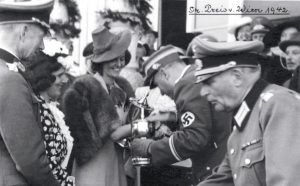 Margit Batthyany-Thyssen, daughter of Heinrich Thyssen-Bornemisza, collecting prizes from National Socialist officials for the Thyssens’ winning horse at the Austrian Derby held in Vienna in 1942, thus legitimising the Nazi regime on behalf of both families (photo Menzendorf, Berlin; copyright Archive of David R L Litchfield) 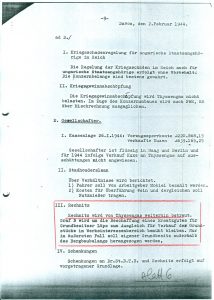 Excerpt from the minutes of the board meetings of the Thyssen-Bornemisza Group held (1939-1944) in Lugano, Flims, Davos and Zurich in the presence of Heinrich Thyssen-Bornemisza, Hans Heinrich Thyssen-Bornemisza, Wilhelm Roelen, General Manager, and Heinrich Lübke, Manager of the August Thyssen Bank in Berlin. This page shows that the company belonging to Heinrich Thyssen-Bornemisza, the father of Margit Batthyany-Thyssen, Thyssensche Gas- und Wasserwerke (Thyssengas) exploited mining interests near the seat of the Thyssen-Bornemisza Family Castle in Rechnitz / Burgenland (Austria) during the Second World War. (photo copyright Archiv David R L Litchfield)
 All in all, at least 800 Jews seem to have been killed in Rechnitz (Austria), seat of the Thyssen-Bornemiszas’ castle and home to Margit Batthyany-Thyssen, in the last phase of the Second World War. The so-called “Rechnitz Massacre” during the night of 24/25 March 1945 is in fact only one of several such murderous events at this location at that time.
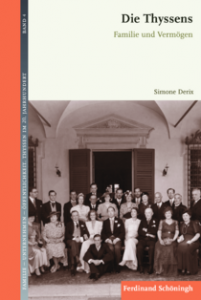 ‘The Thyssens. Family and Fortune’ is volume 4 of the series ‘Family – Enterprises – Public. Thyssen in the 20th Century’ sponsored by the Fritz Thyssen Foundation of Cologne and published by Ferdinand Schöningh Verlag, Paderborn, Germany. Seven pages of the 500-page book are devoted to the Batthyany-Thyssens’ life in Rechnitz during World War Two and in particular their implication in the so-called “Rechnitz Massacre” (photo copyright Ferdinand Schöningh Verlag, Paderborn). This book is a short version of Derix’s habilitation thesis and will thus be accepted as fact by German academics, a qualification that we strongly object to.
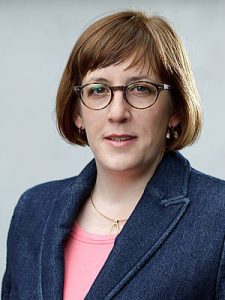 Simone Derix, author of ‘The Thyssens. Family and Fortune’, one of ten German academics commissioned by the Fritz Thyssen Foundation with the rewriting of the Thyssens’ history, continues what appears to be a white-wash and extenuation (photo copyright Historisches Kolleg, Munich). The Historisches Kolleg, where Simone Derix presented her book, is also, by the way, an institution that is itself partly funded by…..the Fritz Thyssen Foundation (!)
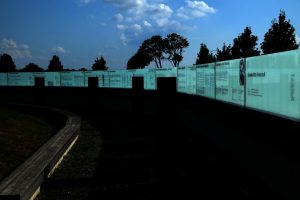 The Kreuzstadl Memorial in Rechnitz to the Jewish victims of the second world war was extended and opened by the Austrian president in 2012. Large information panels include the information that Margit Batthyany never had to give evidence in court on the Rechnitz massacre of 24/25 March 1945. This was despite the fact that German investigators in 1963 reported to the Austrian Ministry of Justice that Margit Batthyany was suspected of having aided and abetted the flight of the two main alleged perpetrators of the crime, Franz Podezin and Joachim Oldenburg (photo copyright übersmeer blog)
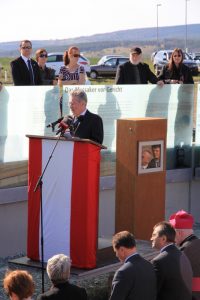 The Austrian head of state who opened the Rechnitz memorial in 2012, Heinz Fischer, assured the public that the Republic of Austria continues in its attempts to locate the graves of the Jews murdered in Rechnitz in 1945. But various Austrian authorities and commemoration associations have also remarked that the commemoration process still does not enjoy a general consensus amongst the population and that the Thyssen and Batthyany families in particular seem to refrain from any kind of positive, pro-active participation in this process of Aufarbeitung and healing (photo copyright Infotronik Austria) 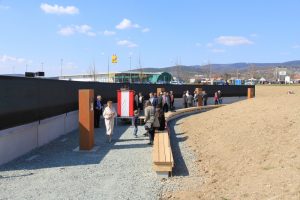 Each year at the end of March, a remembrance event takes place at the Rechnitz Kreuzstadl Memorial Museum, organised by the Refugius commemoration association. While the commemoration event was particularly welcomed and supported by the former Rechnitz mayor, Engelbert Kenyeri, and more and more inhabitants of Rechnitz attend the event, so far, not a single member of either the Thyssen or Batthyany families have participated publicly, despite their fervent statements of intentions made following our publication and the ensuing staging in various European cities of Elfriede Jelinek’s play ‘Rechnitz. The Exterminating Angel’ (photo copyright Infotronik Austria)
|
Tags: 'Gaby' Bentinck, active remembrance, Adolf Eichmann, agent, agricultural estates, Albert Speer, alibi, allied intelligence services, anti-fascist, anti-semitic, Armaments Minister, armed international conflicts, Association of German Historians, Aufarbeitung, Auschwitz, Austria, Austrian amnesties, Austrian authorities, Austrian Derby, Austrian Justice Ministry, Austrian President, Bad Homburg, Batthyany-Thyssen castle, Bavaria, Berlin, Bolshevists, Bozsok, Buchs, Bucsu camp, Budapest Jews, Burgenland, business dealings, Carl-Erdmann-Prize, castle cellar inmates, Central Office of the County Judicial Administrations for the Clearing up of Nazi Crimes, commemoration work, comradeship evening, concentration camp, conspiratorial murders, criminal justice investigations, Davos, death marches, Denmark, Dortmund, Düns, Dutch financial instruments, Eduard Nicka, Eleonore Lappin-Eppel, Emmerich Cserer, end-phase crimes, Erlenhof stud farm, Eva Holpfer, Eva Schwarzmayer, family archives, Family. Enterprises. Public. Thyssen in the 20th Century, fascist, Feldkirch, feudal overlords, final solution, financially contributing member of the SS, Flims, Forced Labour, Franz Cserer, Franz Ostermann, Franz Podezin, French military government, Fritz Thyssen, Fritz Thyssen Foundation, Gabor Zichy, gas chambers, Gauleiter of Styria, German Derby, German war effort, German War Graves Commission, Germany, Gestapo, guilt, Hamburg, Hanover, Hans Anthofer, Hans-Joachim Oldenburg, Heini Thyssen, Heinrich Thyssen-Bornemisza, Heinz Fischer, Hermann Schwarz, high-level contacts, Hildegard Stadler, Hitler Youth, Hoppegarten, Horst Littmann, host country, Hugh Trevor-Roper, Hungarian aristocracy, Hungarian fascists, Hungary, hunting season, Hytec, industrialisation, intelligence, Interpol, investments, Ivan Batthyany, Jewish cemetery, Jews, Johann Paal, Josef Hotwagner, Josef Mandel, Josef Muralter, Josef Thyssen, Josi Groh, Kiel, Köszeg, Kreuzstadl, Kurt Griese, Lake Lugano, Landswerth horse racing stables, legitimisation of the Nazi regime, London, Ludwig Groll, Ludwigsburg, Lugano, Miklos Horthy, mining interests, moral and legal responsibility, munitions, murder investigation, museum, National Socialists, nationhood, Naumburg/Saale, Nazi Germany, Nazi ideology, Nazi Party, Nazi regime, Nazi-occupied Europe, Nazi-state elite, neutrality, Nordlicht, Oberwart, Obringhoven agricultural estate, Office of the Burgenland County Government, organisation Todt, Otto Ickowitz, Paul Szomogyi, people of Rechnitz, People's Court, popular consensus, Poschendorf, privileged lifestyle, prosecution, prosecutor, punishment, racing stables, racist, Ralph Giordano, reactionary landed gentry, Rechnitz, Rechnitz Castle, Rechnitz estate, Rechnitz Massacre, Rechnitz Memorial, Rechnitz war crimes, Red Army, Refugius commemoration association, regime of terror, Reichs Crystal Night, reinforced defense system, remembrance culture, research into the wealthy, Rittergut Gleina, Rittergut Götschendorf, Rittergut Neu Schlagsdorf, role models, Ruhr, Ruhr factories, Russians, SA-member, Sacha Batthyany, Sacre Coeur, Schachendorf, Schloss Puchhof, Schweizermeierhof, Schwerin, scorched earth, Settebello, sexual penchant, Sigfried Uiberreither, Simon Wiesenthal, Simone Derix, Slavs, social position, solidarity, Sondereinsatzkommando, South Africa, South America, South-East Earth Wall, Soviet occupation, Soviet Union, SS, SS-Hauptscharführer, Stefan Beigelböck, Stefan Klemp, Stephan Thyssen-Bornemisza, stigmatisation, suppression of labour movements, Swiss authorities, Swiss cantonal police, Swiss citizenship, Swiss Police Gazette, Swiss State Security File, Switzerland, synergies, tax reasons, The Thyssen Art Macabre, The Thyssens. Family and Fortune, Thyssen AG, Thyssen managers, Thyssengas, Thyssensche Gas- und Wasserwerke, Ticino safehaven, transfer of assets, truth, Uckermark, Uruguay, victimisation, Vienna, Villa Favorita, vindication of culprits, Volksgemeinschaft, Volkssturm, Vorarlberg, Walsum coal mine, Walter Manoschek, weapons, Wehrmacht, Wilhelm Weiss, witness, World War Two, Zurich
Posted in The Thyssen Art Macabre, Thyssen Corporate, Thyssen Family Comments Off on Simone Derix Shrouds Thyssen Guilt – Rechnitz Revisited II


